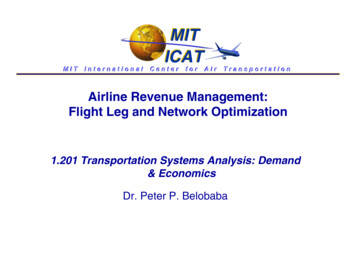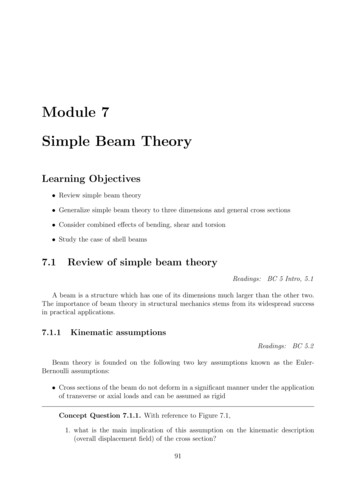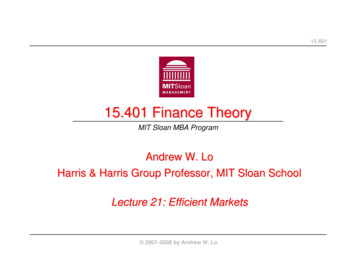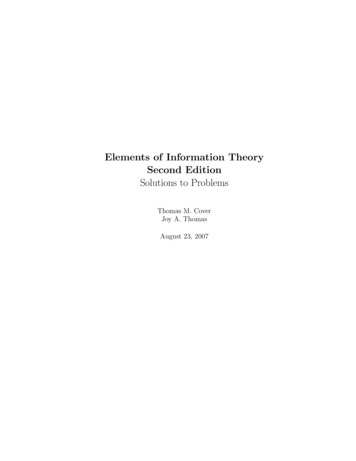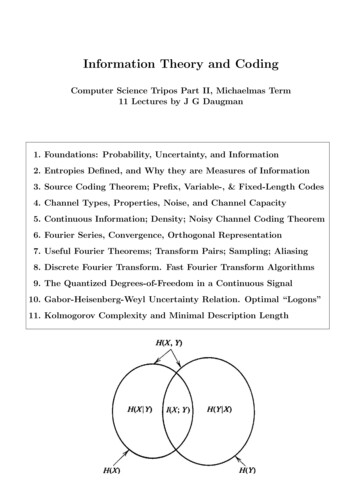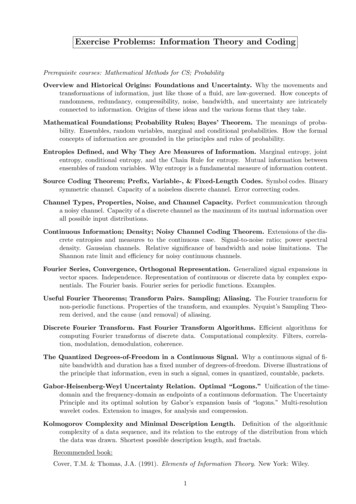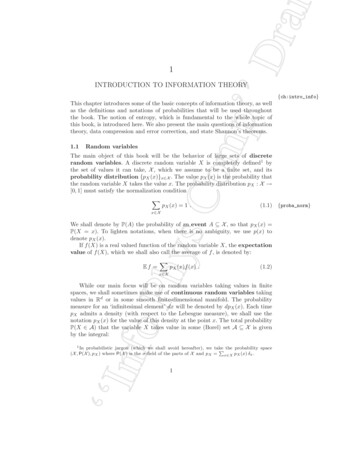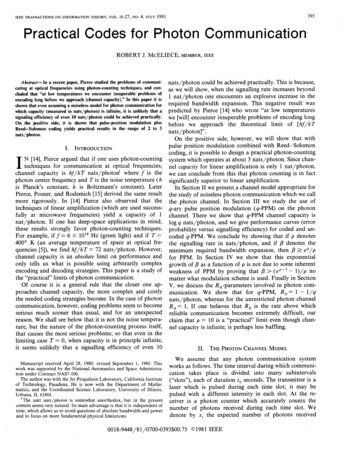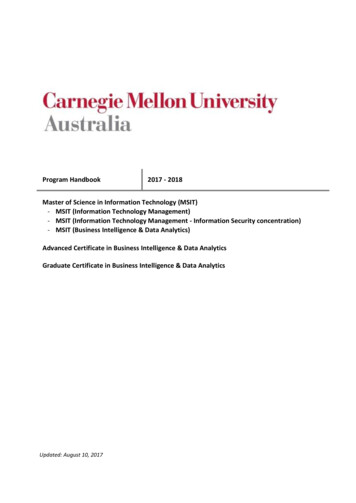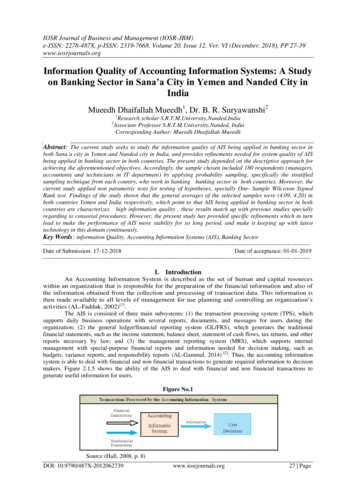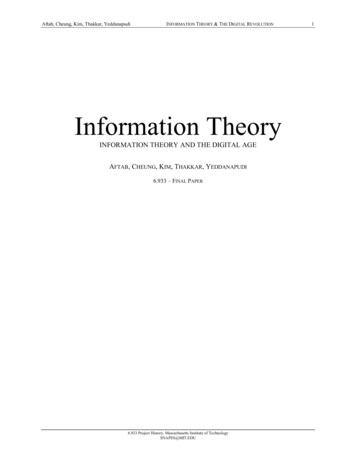
Transcription
Aftab, Cheung, Kim, Thakkar, YeddanapudiINFORMATION THEORY & THE DIGITAL REVOLUTIONInformation TheoryINFORMATION THEORY AND THE DIGITAL AGEAFTAB, CHEUNG, KIM, THAKKAR, YEDDANAPUDI6.933 – FINAL PAPER6.933 Project History, Massachusetts Institute of TechnologySNAPES@MIT.EDU1
Aftab, Cheung, Kim, Thakkar, YeddanapudiINFORMATION THEORY & THE DIGITAL REVOLUTION2INTRODUCTIONInformation Theory is one of the few scientific fields fortunate enough to have an identifiablebeginning - Claude Shannon's 1948 paper. The story of the evolution of how it progressed froma single theoretical paper to a broad field that has redefined our world is a fascinating one. Itprovides the opportunity to study the social, political, and technological interactions that havehelped guide its development and define its trajectory, and gives us insight into how a new fieldevolves.We often hear Claude Shannon called the father of the Digital Age. In the beginning of his paperShannon acknowledges the work done before him, by such pioneers as Harry Nyquist and RVL.Hartley at Bell Labs in the 1920s. Though their influence was profound, the work of those earlypioneers was limited and focussed on their own particular applications. It was Shannon’sunifying vision that revolutionized communication, and spawned a multitude of communicationresearch that we now define as the field of Information Theory.One of those key concepts was his definition of the limit for channel capacity. Similar toMoore’s Law, the Shannon limit can be considered a self-fulfilling prophecy. It is a benchmarkthat tells people what can be done, and what remains to be done – compelling them to achieve it.What made possible, what induced the development of coding as a theory, andthe development of very complicated codes, was Shannon's Theorem: he toldyou that it could be done, so people tried to do it.[Interview with Fano, R. 2001]In the course of our story, we explore how the area of coding, in particular, evolves to reach thislimit. It was the realization that we were not even close to it that renewed the interest incommunications research.Information Theory was not just a product of the work of Claude Shannon. It was the result ofcrucial contributions made by many distinct individuals, from a variety of backgrounds, whotook his ideas and expanded upon them. Indeed the diversity and directions of their perspectivesand interests shaped the direction of Information Theory.In the beginning, research was primarily theoretical, with little perceived practical applications.Christensen says that the innovator's dilemma is that he cannot garner support for his new ideasbecause he cannot always guarantee an end profit. Fortunately, Information Theory wassponsored in anticipation of what it could provide. This perseverance and continued interesteventually resulted in the multitude of technologies we have today.In this paper, we explore how these themes and concepts manifest in the trajectory ofInformation Theory. It begins as a broad spectrum of fields, from management to biology, allbelieving Information Theory to be a 'magic key' to multidisciplinary understanding. As thefield moved from this initial chaos, various influences narrowed its focus. Within theseestablished boundaries, external influences such as the space race steered the progress of thefield. Through it all, the expansion of Information Theory was constantly controlled by hardware6.933 Project History, Massachusetts Institute of TechnologySNAPES@MIT.EDU
Aftab, Cheung, Kim, Thakkar, YeddanapudiINFORMATION THEORY & THE DIGITAL REVOLUTION3technological limitations – indeed, the lack of such technology caused the ‘death’ of InformationTheory, and its widespread availability is behind its current overwhelming success.SHANNON’S “MATHEMATICAL THEORY OF COMMUNICATION”“Before 1948, there was only the fuzziest idea of what a message was. Therewas some rudimentary understanding of how to transmit a waveform andprocess a received waveform, but there was essentially no understanding of howto turn a message into a transmitted waveform.”[Gallager, Claude Shannon: A Retrospective, 2001 pg. 2683]In 1948, Shannon published his paper “A Mathematical Theory of Communication” in the BellSystems Technical Journal. He showed how information could be quantified with absoluteprecision, and demonstrated the essential unity of all information media. Telephone signals, text,radio waves, and pictures, essentially every mode of communication, could be encoded in bits.The paper provided a “blueprint for the digital age”1Since the Bell Systems Technical Journal was targeted only towards communication engineers,mathematician Warren Weaver “had the feeling that this ought to reach a wider audience than(just) people in the field” recalls Betty Shannon2. He met with Shannon, and together, theypublished “The Mathematical Theory of Communication” in 1949. The change from “A” to“The” established Shannon’s paper as the new “scripture” on the subject – it allowed to reach afar wider group of people.Why was Shannon’s paper so influential? What was it about this paper that people refer to it asone of the greatest intellectual triumphs of the twentieth century? The answer lies in thegroundbreaking concepts that A Mathematical Theory of Communication contains. Concepts thatwere influential enough to help change the world.There are actually four major concepts in Shannon’s paper. Getting an idea of each is essential inunderstanding the impact of Information Theory.Channel Capacity & The Noisy Channel Coding TheoremPerhaps the most eminent of Shannon’s results was the concept that every communicationchannel had a speed limit, measured in binary digits per second: this is the famous ShannonLimit, exemplified by the famous and familiar formula for the capacity of a White GaussianNoise Channel:C t W log 212P NNGallager, R. Quoted in Technology Review,Shannon, B. Phone Interview6.933 Project History, Massachusetts Institute of TechnologySNAPES@MIT.EDU
Aftab, Cheung, Kim, Thakkar, YeddanapudiINFORMATION THEORY & THE DIGITAL REVOLUTION4The bad news is that it is mathematically impossible to get error free communication above thelimit. No matter how sophisticated an error correction scheme you use, no matter how much youcan compress the data, you can not make the channel go faster than the limit without losing someinformation.The good news is that below the Shannon Limit, it is possible to transmit information with zeroerror. Shannon mathematically proved that there were ways of encoding information that wouldallow one to get up to the limit without any errors: regardless of the amount of noise or static, orhow faint the signal was.Of course, one might need to encode the information with more and more bits, so that most ofthem would get through and those lost could be regenerated from the others. The increasedcomplexity and length of the message would make communication slower and slower, butessentially, below the limit, you could make the probability of error as low as you wanted.To make the chance of error as small as you wish? Nobody had ever thought ofthat. How he got that insight, how he even came to believe such a thing, I don'tknow. But almost all modern communication engineering is based on that work.[Fano, R. Quoted in Technology Review, Jul 2001]The noisy channel coding theorem is what gave rise to the entire field of error-correcting codesand channel coding theory: the concept of introducing redundancy into the digital representationto protect against corruption. Today if you take a CD, scratch it with a knife, and play it back itwill play back perfectly. That’s thanks to the noisy channel theorem.Formal Architecture of Communication SystemsThe following diagram illustrates the formal architecture Shannon offered as a schematic for ageneral communication system. Flip open to the beginning of any random textbook oncommunications, or even a paper or a monograph, and you will find this diagram.Figure 1. From Shannon’s “A Mathematical Theory of Communication”, page 3.This figure represents one of the great contributions of A Mathematical Theory ofCommunication: the architecture and design of communication systems. It demonstrates that any6.933 Project History, Massachusetts Institute of TechnologySNAPES@MIT.EDU
Aftab, Cheung, Kim, Thakkar, YeddanapudiINFORMATION THEORY & THE DIGITAL REVOLUTION5communication system can be separated into components, which can be treated independently asdistinct mathematical models. Thus, it is possible to completely separate the design of the sourcefrom the design of the channel. Shannon himself, realized that his model had “applications notonly in communication theory, but also in the theory of computing machines, the design oftelephone exchanges and other fields.”3All of today’s communication systems are essentially based on this model – it is truly ‘ablueprint for the digital age’Digital RepresentationShannon also realized that the content of the message was irrelevant to its transmission: it did notmatter what the message represented. It could be text, sound, image, or video, but it was all 0’sand 1’s to the channel. In a follow-up paper, Shannon also pointed out that once data wasrepresented digitally, it could be regenerated and transmitted without error.This was a radical idea to engineers who were used to thinking of transmitting information as anelectromagnetic waveform over a wire. Before Shannon, communication engineers worked ontheir own distinct fields, each with its own distinct techniques: telegraphy, telephony, audio anddata transmission all had nothing to do with each other.Shannon’s vision unified all of communication engineering, establishing that text, telephonesignals, images and film – all modes of communication – could be encoded in bits, a term thatwas first used in print in his article. This digital representation is the fundamental basis of all wehave today.Efficiency of Representation: Source CodingIn his paper, Shannon also discusses source coding, which deals with efficient representation ofdata. Today the term is synonymous with data compression. The basic objective of source codingis to remove redundancy in the information to make the message smaller. In his exposition, hediscusses a loss-less method of compressing data at the source, using a variable rate block code,later called a Shannon-Fano code.A challenge raised by Shannon in his 1948 paper was the design of a code that was optimal inthe sense that it would minimize the expected length. (The Shannon-Fano code which heintroduced is not always optimal). Three years later, David Huffman, a student of Prof. Fano’sclass at MIT came up with Huffman Coding, which is widely used for data compression. JPEGS,MP3s and .ZIP files are only some examples.Entropy & Information ContentAs we’ve discussed, Shannon’s paper expressed the capacity of a channel: defining the amountof information that can be sent down a noisy channel in terms of transmit power and bandwidth.In doing so, Shannon showed that engineers could choose to send a given amount of informationusing high power and low bandwidth, or high bandwidth and low power.3Shannon, C. A Mathematical Theory of Communication, pg. 36.933 Project History, Massachusetts Institute of TechnologySNAPES@MIT.EDU
Aftab, Cheung, Kim, Thakkar, YeddanapudiINFORMATION THEORY & THE DIGITAL REVOLUTION6The traditional solution was to use narrow-band radios, which would focus all their power into asmall range of frequencies. The problem was that as the number of users increased, the numberof channels began to be used up. Additionally, such radios were highly susceptible tointerference: so much power was confined to a small portion of the spectrum that a singleinterfering signal in the frequency range could disrupt communicationShannon offered a solution to this problem by redefining the relationship between information,noise and power. Shannon quantified the amount of information in a signal, stating that is theamount of unexpected data the message contains. He called this information content of amessage ‘entropy’. In digital communication a stream of unexpected bits is just random noise.Shannon showed that the more a transmission resembles random noise, the more information itcan hold, as long as it is modulated to an appropriate carrier: one needs a low entropy carrier tocarry a high entropy message. Thus Shannon stated that an alternative to narrow-band radios wassending a message with low power, spread over a wide bandwidth.Spread spectrum is just such a technique: it takes a narrow band signal and spreads its powerover a wide band of frequencies. This makes it incredibly resistant to interference. However itdoes use additional frequency ranges, and thus the FCC until recently had confined the techniqueto the military. It is now widely used in CDMA cellular phones.Now that we’ve discussed some of the fundamental concepts in Shannon’s work, let’s take a stepback and see how the formalization of these concepts started a chain of research that eventuallybecame known as the field of Information Theory.TRAJECTORY OF INFORMATION THEORY - IWe begin by exploring the history of Information Theory, how the field evolved and weatheredvarious influences to become what it is today. In essence, we chart the trajectory of a newscience.Creating the FieldInformation Theory grew out of the concepts introduced in "A Mathematical Theory ofCommunication." Although, the phrase "information theory" was never used in the paper,Shannon's emphasis on the word "information" probably helped coin the term. The idea thatsomething as nebulous as "information" could be quantified, analyzed, and reduced to amathematical formula attracted tremendous attention.This initial excitement gave life to the field. But what were the forces that enabled this process?According to Latour, one of the tasks in creating a new field is gathering the support andenthusiasm of t
believing Information Theory to be a 'magic key' to multidisciplinary understanding. As the field moved from this initial chaos, various influences narrowed its focus. Within these established boundaries, external influences such as the space race steered the progress of the field. Through it all, the expansion of Information Theory was constantly controlled by hardware . Aftab, Cheung, Kim .
